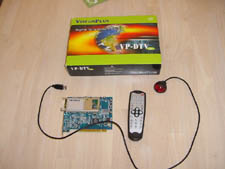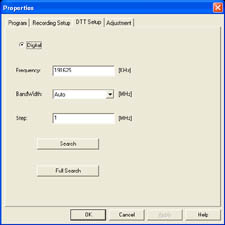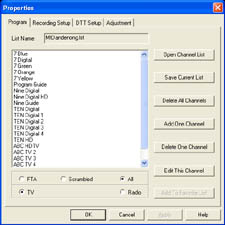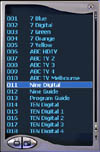|
|
Advertisement:
|
|
VisionPlus DVB-T Digital TV Tuner Card |
|
Join the community - in the OCAU Forums!
|
The Card, Installation and Testing
VisionPlus DVB-T card
Cost: $330 (includes Digibox software and postage) – please note the card I received (first shipment) cost $297 and did not include Digibox software. Digibox software is not covered by this review.
The VisionPlus card arrived in an Express Post package from Renura. The box contained:- IR Remote control with AAA batteries included
- IR USB Receiver
- PCI card
- CD with WinDTV software

Installation
Installation of the card was simple. I installed the PCI card, connected the USB receiver and connected a standard antenna cable from the nearest coaxial port in the house (I later purchased a 10m extension cable).
Installing the software was also just as simple – a normal installation program run as ‘Administrator’ installed the drivers and software. It was pleasing to note the drivers were digitally signed (by Microsoft) and have not yet crashed the PC despite hours of testing. No reboot was required.
The Test Systems:
- Receiving, Recording and Playback
ASUS A7N8X-X Motherboard
AMD ‘Palomino’ AthlonXP 1800+ CPU
512M ValueRAM DDR400 Kingston Memory
GeForce 3 Ti 200 graphics card
Turtle Beach Santa Cruz soundcard connected to 5.1 setup
Intel Pro 1000M Gigabit LAN
Windows XP Professional
- Playback
Dell Inspiron 8500 Notebook
1G DDR Memory
60G Hard disk
GeForce 4 GO 440 Graphics
1920x1200 WUXGA screen (capable of HD resolution)
Broadcom 440x 10/100 NIC
Windows XP Professional
Channel Setup
The WinDTV software has two modes of searching for channels – automatic and manual. Automatic detection appears to scan through the entire band looking for Digital TV signals. From the speed it was going, it looked set to take a long time (and I had also heard from other users that it was unsuccessful). The process could be speeded up by changing the step from 1MHz to 7MHz (since all channels are 7MHz wide).
I decided to manually enter the channels. There are two ways of doing this. The first is to enter a frequency and press search – this will lock onto this frequency and discover the various channels on that frequency (i.e. enter the Ten frequency and it should discover Ten Digital, Ten HD, etc). The other option is to manually add the individual streams by entering the frequency and VPID/APID (which are ‘stream’ identifiers). Since I had no idea how to find out the VPID/APID, I opted for the frequency only option.

Knowing I received my signals from Mt Dandenong, I looked up the DBA website to obtain the centre frequencies for my area. I entered the frequency for Ten, and press search. The software detected all the various sub-streams. I then proceeded with the other broadcasters, and saved the list to a file.
I later discovered that not all the channels were detected correctly. For example, “Nine Digital” was actually the Nine Digital HD demo loop, and the real channel Nine didn’t appear at all. I repeated the search, and this time “Nine Digital” was correct, but the HD channel had disappeared! A similar thing happened with Ten as well. I later called up Nine and a helpful technician gave me the VPIDs and APIDs which I manually corrected with the “Edit This Channel” function.

It is obvious that the channel detection is buggy and will hopefully be corrected in the next version of WinDTV.
TV Viewing
The TV viewing software initially opens in a 4:3 window. Since almost all the content in Australia seems to be in anamorphic 16:9 (4:3 programs have black sidebars) the software needs to be changed to 16:9 (easily done).
The channel can be chosen by double-clicking in the channel list (in the Properties window) or from the favourites list (with mouse or remote control). Channel changing takes a second or two.

The picture quality of the SD channels was simply amazing. The windows can be resized to any desirable size. Even stretched across a 1920x1200 display the SD programs still looked quite good.
Unfortunately the HD channels were more problematic. Seven Orange (576p) often broke up with squealing sounds through the speakers. Nine HD and Ten HD usually ran at only a couple of frames per second, with no sound. On occasion, the channels would run at normal frame-rate but still without sound.
The WinDTV would also often crash or freeze when switching channels. When it froze, it would have to be killed from Task Manager.

Another annoying problem with WinDTV was the full screen viewing mode. The aspect ratio could not be selected, and it would simply fit it to whatever the screen resolution was. At 1024x768 the programming was squashed horizontally – there was no option to letterbox the 16:9 content. When watching the live stream on the video projector, I had to resize the window as large as it would fit (keeping 16:9 aspect) and set a black wallpaper, and hide the task bar. Obviously the title-bar was still present. The only other way to watch full screen was to record a program and play it back later with WinDVD or PowerDVD.
I was informed that installing PowerDVD 5 would allow the HD channels to be viewed correctly – this proved true – I was able to watch Seven Orange, Nine HD and Ten HD (although the latter two still did not have sound). However, the still capture feature now crashed all the time and the software now did not run properly as a regular user (would stall after about 1 second of TV).
|
|
Advertisement:
All original content copyright James Rolfe.
All rights reserved. No reproduction allowed without written permission.
Interested in advertising on OCAU? Contact us for info.
|

|


